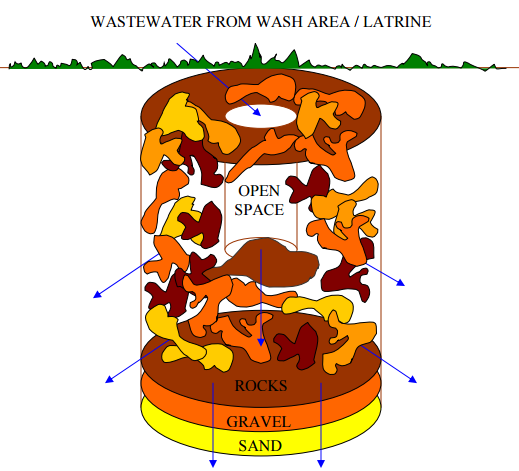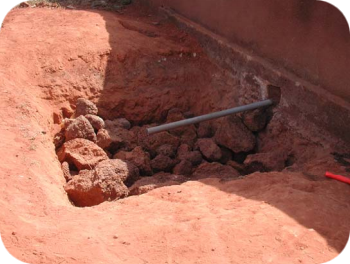Application: Aquifers, bore wells, dug wells, farms, reservoirs
Description: A soak pit, also known as a soak-away or leach pit, is a covered, porous-walled chamber that allows water to slowly soak into the ground and thereby recharge groundwater. As wastewater percolates through the soil from the soak pit, small particles are filtered out by the soil matrix and organics are digested by microorganisms. The wastewater effluent is absorbed by soil particles and moves both horizontally and vertically through the soil pores. It can be left empty and lined with a porous material to provide support and prevent collapse, or left unlined and filled with coarse rocks and gravel. The rocks and gravel will prevent the walls from collapsing, but will still provide adequate space for the wastewater. In both cases, a layer of sand and fine gravel should be spread across the bottom to help disperse the flow. To allow for future access, a removable (preferably concrete) lid should be used to seal the pit until it needs to be maintained.
Contribution to climate resilience: Soak pits facilitate recharging of groundwater by partially treating wastewater, greywater and stormwater and allowing it to slowly soak into the ground. This increases the availability of water during the dry season, which is likely to become more severe with climate change. Because they are constructed using local labour and locally available materials, they can be repaired quickly, making them very resilient to both routine wear-and-tear and natural disasters.
Supplementary sources of information:
http://www.sswm.info/content/soak-pits
http://hubpages.com/living/Soak-pit-An-easy-way-to-recharge-ground-water-level
http://civildigital.com/need-soak-pit-tank/
Background image credit: http://sewertreatment.in/soak-pit-construction
This resilience-building measure is sourced from the Water Resource Adaptation Guide (2019) published by the National Council for Sustainable Development at the Ministry of Environment in Cambodia. The full Guide is available to download at URL https://ncsd.moe.gov.kh/sites/default/files/2019-10/Water%20Resources%20Adaptation%20Guide_March%202019_En.pdf


